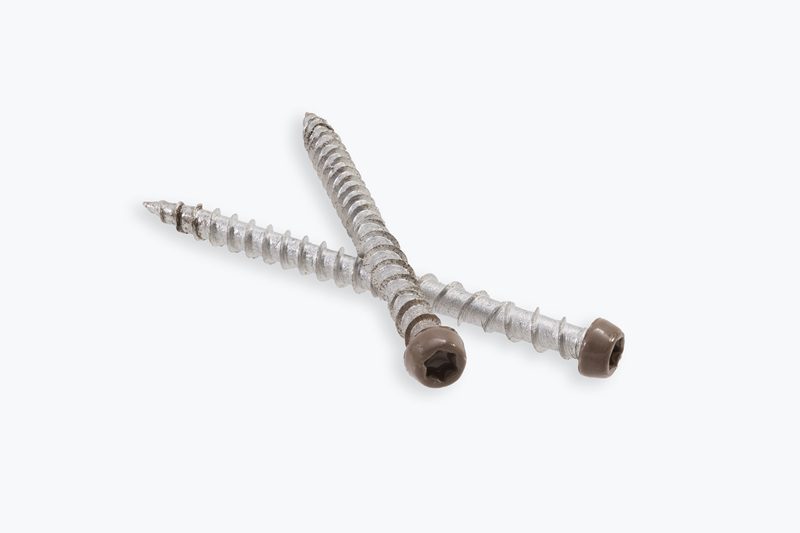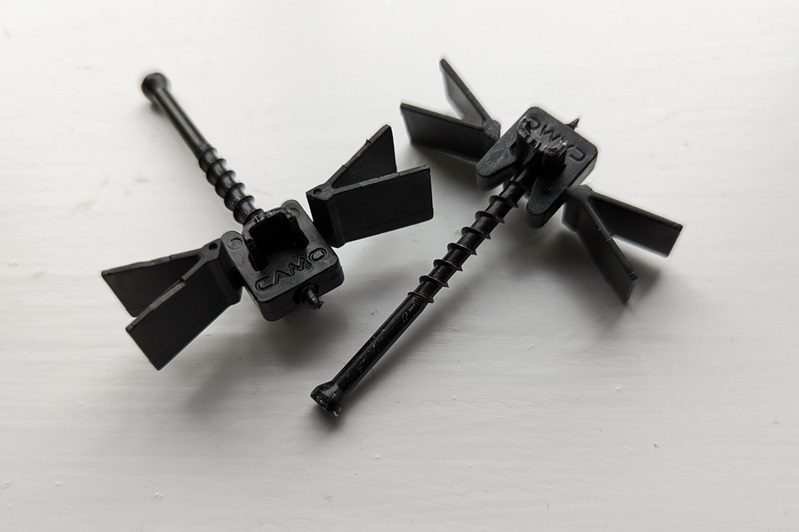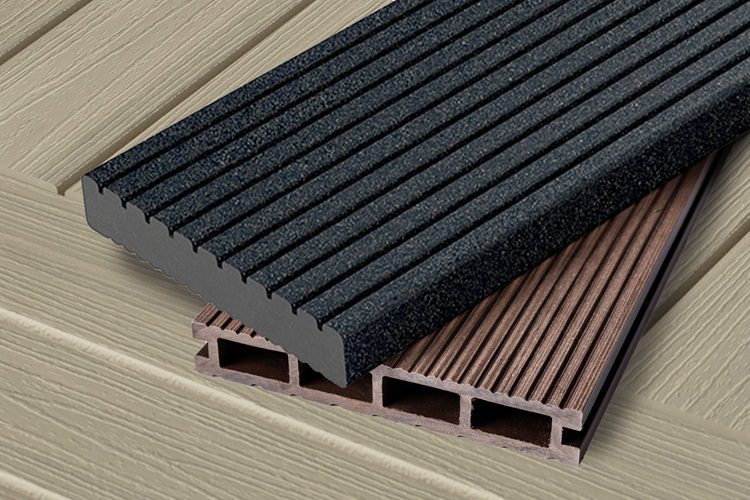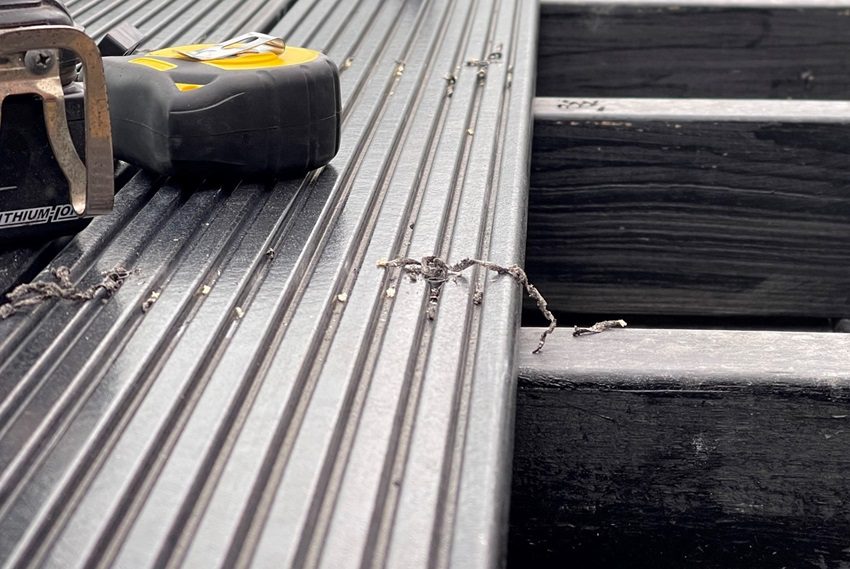There are two main ways to fix composite decking: using hidden deck clips (also called fasteners), or decking screws and face-fixing them onto the decking. Whether clips or screws are the right fastening for your project depends on a number of factors, which we explore below.
Read on to learn:
- The difference between hidden fastening and face-fixing systems
- Deck clips VS screws: How to choose the right fastening
- What to consider when purchasing clips and screws for a composite deck area
What is face-fixing?
If you screw into composite decking to fasten it down, you’re face-fixing it. This involves drilling down into the face of the deck board to drive a screw into place which fixes the board directly to the subframe below. For a cleaner finish, opt for screw heads or plugs in colours that match those of your decking boards – this will help hide the screw.
What size and how many deck screws you need per board depends on the board itself. Always read the manufacturer’s instructions and guidance on how to screw down the deck boards before getting your drill out.

Advantages of using composite decking screws
Composite decking screws are the most common fixing method for a few reasons:
- It’s how timber decking is fastened, so it’s widely recognised and understood
- Screws have a more traditional look, giving composite boards more of an authentic finish
View all decking screws and clips or learn more about the screws you need to fit composite decking.
What is a hidden fastening system for decking?
Your other option is using a hidden fastening system, which requires hidden decking clips. Unlike screws which are visible on top of the board, composite decking clips are attached inside grooves running down the side of the boards. The fastener is clipped into this channel and then the clip is screwed into the frame support joist. Both are hidden away, hence the name of this fastening system.

Advantages of using composite decking clips
Like screws, hidden deck clips also offer many benefits:
- Clips should make the board easier to remove if it needs replacing
- They offer a clean aesthetic, as fastenings aren’t visible on the finished deck
- They automatically space the composite deck boards with the correct gaps for expansion and contraction
Composite deck clips VS screws
So, which is better? It all depends on the look that your customer wants to achieve. Don’t be fooled by reports that one method allows a faster installation than the other. Take this with a pinch of salt, because it all depends on how adept you are with each method.
If you’re more used to screwing down deck boards, then you’re more likely to be quicker or more comfortable using screws. If you’ve only ever relied on hidden composite decking clips, then that’s probably always going to be your preferred method of fastening.
Which deck boards should be screwed down?
Screws tend to be used to fasten:
- Uncapped deck boards
- Solid boards
Which types of decking are hidden clips best for?
Generally speaking, boards that are hollow are fixed with deck clips. This is because their hollow structure means they don’t have anywhere for the screw to grip to. You should never screw directly through the top of a hollow composite deck board, as this will cause irreversible damage to the board. You should always use hidden decking clips.
For more details about the different types of composite decking boards, read our blogs:
- The difference between capped and uncapped composite decking
- What’s the difference between hollow and solid composite boards?
- The difference between grooved and ungrooved composite decking

Fixing systems for Ecodek brands
The design and make up of your chosen deck board will determine the fixings you require. Our premium capped decking collection, Evolution, uses a hidden clip fixing system. Our uncapped collections of boards – Heritage, Signature AT and Signature HD (wood effect, ribbed and grooved, and heavy duty) are all face-fixed – and are all solid for exceptional quality.
It’s wise to ask your decking manufacturer or supplier which fixing method your chosen boards should use, as this can have an impact on the overall finish of your project. We also recommend that our boards are selected based on their aesthetics rather than their fixing system, as clips and screws both allow for a quality installation.
What to consider when buying composite decking screws and clips
All this in mind, you’re nearly there with choosing the best deck clips or screws to install boards for your next decking project. There’s just a few more things to consider, which we’ve outlined below.
1. Choose the right fixings
Before purchasing any composite screws or clips, make sure you read the manufacturer’s installation instructions to determine which type of fixing has been recommended. Even better, you could speak to your decking supplier directly to get all the information you need to know pre-installation.
Remember, if your decking is hollow, don’t use screws instead of clips – this will cause big installation issues and most likely void your warranty! Equally, you can only use clips if your boards have grooves. And if you do use clips, you may find that some of your boards or fascias are face fixed, so read through your installation instructions prior to starting the job. Our capped boards use a clip system, but the first and last boards are always face fixed for extra strength.
You also need to account for the size and aesthetic of your decking when choosing your screws and clips. Whether you’re installing black, grey, or brown composite decking, strive for fastenings in colours that complement or blend in with the boards.
It’s just as important to ensure you have the correct fixings for PVC boards, such as our extra wide PVC decking, as these boards can sometimes require different screw types. Learn more about how PVC boards differ from composite boards, and their additional installation considerations: Composite decking vs PVC decking.
2. Use the manufacturer’s recommended screws or clips
It’s important to use the specific brand, size, or material of fixings recommended by your decking manufacturer. Using an alternative can be cheaper, but will often result in damaging the boards and voiding the warranty.
It’s vital to use screws that have been specifically designed for use on composite materials. Ecodek’s screws are made from stainless steel, have a coarser thread for better fixing, and a concave head for a more seamless finish, making them the perfect fastening for composite boards. Check out our article for more guidance on face-fixing with steel screws: How to screw down composite decking.
3. Calculating the right amount
Make sure you know how many decking screws or clips you need before installation begins. There’s nothing worse than not being able to complete a job because you underestimated the number of fixings required!
Use our online decking calculator to get an approximation of how many you’ll need, or speak to us directly – we can work out exactly how many screws or clips your composite decking project needs.
